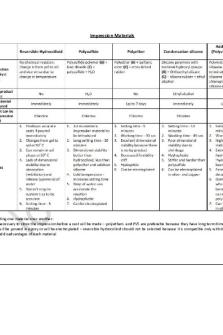Tribology materials (Surfaces) PDF

| Title | Tribology materials (Surfaces) |
|---|---|
| Author | Mohnish Mulgi |
| Course | Tribology |
| Institution | Imperial College London |
| Pages | 4 |
| File Size | 794.7 KB |
| File Type | |
| Total Downloads | 58 |
| Total Views | 144 |
Summary
Summary notes for exam revision. Download my Onenote alongside this document for the full notes and references....
Description
Tribology materials (Surfaces) 11 February 2021
10:29 PM
Tribological compatibility
- Solid solubility and wear resistance of metal pairs
For conformal contacts, where the surface area is large dissimilar metals will be bad
- Elements solubility - how much the elements mix with each other, If they are soluble the 2 surfaces will merge together
Lubricating passive metals - Metals like stainless steel, chromium and titanium are difficult to lubricate due to their underactivity with boundary additives
- Oxides on surfaces are stable, hence harder to react with an additive
- The yellowish region shows the oxide layer
Materials requirements
- To meet the requirements a soft thin material layer like Tin or Lead is coated on a hard material - To avoid scuffing the soft alloy should also have low adhesion to steel
Tribology Page 1
- However, the coating thickness for the Tin decreases the fatigue strength exponentially Therefore, a triple layer can be used to give even better results - To improve the corrosion resistance Aluminium can be added, however it's compatibility is 'fair' as it is soluble with the stainless steel Silica (sand particles) are added to prevent the mixing as Al is softer it is abraded off
Main types of metallic plain bearing materials
Fatigue strength and operating temperature The operating temperature needs to be considered when choosing the materials, some may be great in other properties but if it doesn't perform as well in the temp range then sacrifices need to be made
Dry bearing materials
- Used for low cost, finite life applications at low speeds and loads - No lubrication needed/if it cannot be used - Usually plastics
Tribology Page 2
Porous materials - They look dry but are porous, the holes contain the lubrication
- The power is sintered - The lubricant is released at the contact allowing for low amounts of lubrication almost dry
Materials for concentrated contacts - Rolling element bearing - They undergo high contact pressure (1 - 4 GPa) and many loading cycles Therefore require high strength and fatigue properties - Normally operate in full film, so wear and friction is less important
- Normally no tensile stresses (mainly compression for rolling element bearing) - Dimensional stability needed
- Rolling contact fatigue resistance is the critical property - use hard, clean steel - Commonly through hardened, high carbon (0.8-1% C, 1.3-1.6% Cr) bearing steels – AISI 52100 (US), 100Cr6 (Europe), EN31 (BS970) – For aerospace applications (M50 is used, 4 - 4.5% Mo)
Materials for concentrated contacts - Gears
Causes crack growth
- Using carburised steels
Tribology Page 3
- However, griding is required to smooth out the surface, instead Nitrided steel can be used
- Using Nitrided steel
- The penetration is lower for Nitrided steels - Other common materials used for gears
- Other common materials used for bearings
Tribology Page 4...
Similar Free PDFs

Tribology materials (Surfaces)
- 4 Pages

Tribology 1
- 36 Pages

Tribology in Machine Design
- 312 Pages

Exchange Surfaces revision
- 9 Pages

Table of Quadric Surfaces
- 1 Pages

Development of surfaces -
- 32 Pages

Materials
- 41 Pages

Quiz 2 - Soapy Bubbly Surfaces
- 4 Pages

Impression Materials
- 2 Pages

Practice Materials
- 34 Pages
Popular Institutions
- Tinajero National High School - Annex
- Politeknik Caltex Riau
- Yokohama City University
- SGT University
- University of Al-Qadisiyah
- Divine Word College of Vigan
- Techniek College Rotterdam
- Universidade de Santiago
- Universiti Teknologi MARA Cawangan Johor Kampus Pasir Gudang
- Poltekkes Kemenkes Yogyakarta
- Baguio City National High School
- Colegio san marcos
- preparatoria uno
- Centro de Bachillerato Tecnológico Industrial y de Servicios No. 107
- Dalian Maritime University
- Quang Trung Secondary School
- Colegio Tecnológico en Informática
- Corporación Regional de Educación Superior
- Grupo CEDVA
- Dar Al Uloom University
- Centro de Estudios Preuniversitarios de la Universidad Nacional de Ingeniería
- 上智大学
- Aakash International School, Nuna Majara
- San Felipe Neri Catholic School
- Kang Chiao International School - New Taipei City
- Misamis Occidental National High School
- Institución Educativa Escuela Normal Juan Ladrilleros
- Kolehiyo ng Pantukan
- Batanes State College
- Instituto Continental
- Sekolah Menengah Kejuruan Kesehatan Kaltara (Tarakan)
- Colegio de La Inmaculada Concepcion - Cebu





